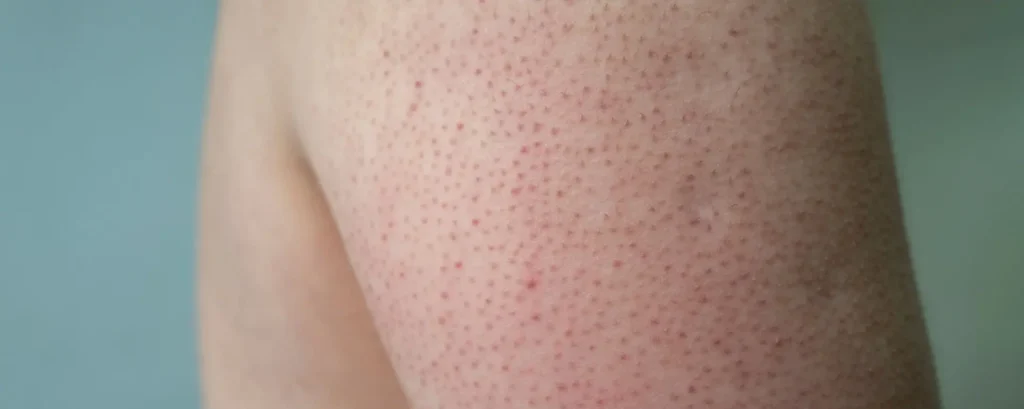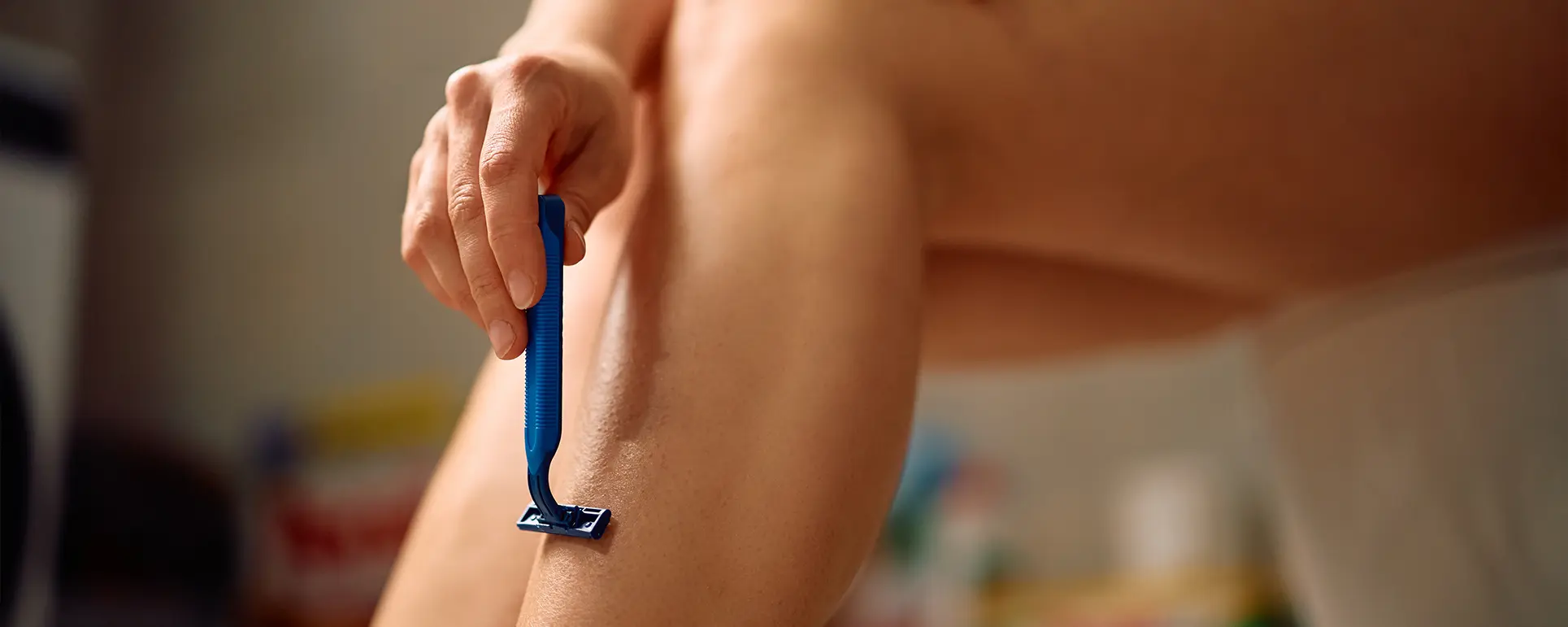Have you ever taken the time to carefully shave your legs, only to notice small dark dots, red bumps, or uneven patches appearing right after? Instead of the silky-smooth finish you were hoping for, your skin might look speckled, rough, or dotted. This is what’s commonly known as strawberry legs a nickname inspired by the dotted seeds that cover the surface of a strawberry. The resemblance is so striking that once you’ve seen it, the comparison makes perfect sense.
For many people, strawberry legs can feel like a letdown. You put effort into grooming, but instead of glowing, flawless skin, you’re left with pores that stand out, dark spots that catch the eye, or irritation that makes your legs look less even. While medically harmless in most cases, the condition can still impact how you feel about your appearance. It can be especially discouraging during warmer months when you want the confidence to wear skirts, shorts, or swimwear without worrying about your skin’s texture.
Strawberry legs often develop because the pores or hair follicles on your legs become more visible after shaving. Sometimes this happens due to trapped hair, clogged pores filled with oil and debris, or the shadow of hair stubble beneath the skin. In other cases, it may be linked to dry skin, razor burn, or even conditions like folliculitis and keratosis pilaris. The good news is that these dots are rarely a sign of something serious. Instead, they’re a cosmetic issue and one that can usually be improved with consistent care.
It’s worth noting that strawberry legs don’t affect everyone in the same way. People with thicker hair, darker hair follicles, or naturally larger pores may notice them more frequently, while others may only experience the issue occasionally after a rushed shave. Skin type also plays a role: those with sensitive or dry skin often find that irritation and pore visibility are worse without a proper pre- and post-shaving routine.
Even though strawberry legs can be stubborn, the problem isn’t permanent. With the right approach including proper exfoliation, shaving with clean and sharp tools, and using moisturisers that keep the skin barrier healthy you can greatly reduce or even prevent them. Over time, these small changes can make your legs look smoother, clearer, and more radiant, helping you feel more confident when you want to show them off.
What Causes Strawberry Legs?

Strawberry legs don’t usually point to anything serious, but the reasons behind them can vary. While the small dark dots may look similar on the surface, the underlying cause differs from person to person. Knowing what’s happening beneath the skin is the first step in preventing or treating the issue effectively. Here are the most common causes:
1. Keratosis Pilaris
Keratosis pilaris, often nicknamed chicken skin, is one of the leading causes of strawberry legs. It occurs when keratin a natural protein that protects the skin builds up and clogs hair follicles. Instead of shedding normally, dead skin cells become trapped in the follicle opening, leaving behind small rough bumps. These bumps may be skin-coloured, red, or dark depending on your skin tone and hair colour. Keratosis pilaris is harmless but can be stubborn and tends to worsen in cold, dry weather. Many people notice it most on their thighs and upper arms, though it can appear anywhere hair follicles are present.
2. Ingrown Hairs
Shaving, waxing, or even epilating can sometimes lead to ingrown hairs. This happens when the hair grows back into the skin instead of emerging from the follicle as it should. Ingrown hairs often look like small dark spots or raised bumps, and in some cases, they can become sore, red, or even infected. People with curly or coarse hair are more prone to ingrown hairs, as the natural curl makes it easier for the strand to coil back beneath the skin’s surface. Using blunt razors, skipping exfoliation, or shaving against the direction of growth all increase the likelihood of this problem.
3. Folliculitis
Folliculitis is the inflammation of hair follicles, and it can look a lot like acne. The follicles may appear red, swollen, or filled with pus in more severe cases. Often, folliculitis happens after shaving, waxing, or sweating, when bacteria or fungi get into irritated follicles. Apart from the dotted look of strawberry legs, folliculitis can also cause itchiness and discomfort. While mild cases often clear on their own, recurrent folliculitis may need targeted treatment to prevent further flare-ups.
4. Dry Skin
Dryness doesn’t directly create strawberry legs but it does make them stand out more. When skin lacks hydration, it becomes flaky and rough, which draws attention to pores and hair follicles. In addition, dry skin increases friction during shaving, leading to irritation and razor burn both of which can exaggerate the appearance of dark spots. If you’re skipping moisturiser after hair removal or not using hydrating products regularly, dryness could be playing a big role in your strawberry legs.
5. Enlarged Pores
Some people naturally have larger pores on their legs, just like some have them on their face. These wide openings are more visible and can collect oil, dirt, or shaving residue, which creates the illusion of dark spots. The shadow of hair stubble just beneath the skin can also make large pores look darker. While pore size is largely genetic, regular exfoliation and cleansing can help reduce the visibility of these dots.
6. Shaving Irritation and Razor Burn
The way you shave can directly affect whether or not you develop strawberry legs. Using a dull razor, shaving without a proper lubricant, or dragging the blade repeatedly over the same spot can cause irritation. This not only inflames the skin but can also make pores more noticeable. Tiny nicks and razor burn often leave behind redness and darkened dots that resemble strawberry seeds. Shaving in a rush or skipping essential prep steps like exfoliation and softening the skin with warm water often makes the issue worse.
7. Excess Oil and Sebum Build-Up
For some, overactive oil glands contribute to the dotted look of strawberry legs. The legs have fewer oil glands than the face, but when sebum combines with dead skin and dirt, it can clog follicles. Once the trapped material oxidises (exposed to air), it darkens similar to how blackheads form on the face. This darkening makes pores look more pronounced and gives the skin that speckled effect.
At-Home Fixes to Reduce Strawberry Legs

The good news about strawberry legs is that, in most cases, you can reduce their appearance with simple at-home remedies. Consistency is key small changes to your routine can make a big difference in how smooth and clear your legs look over time. Here are some of the most effective fixes:
1. Exfoliate Regularly
One of the most effective ways to prevent strawberry legs is by exfoliating. Dead skin cells often clog hair follicles, making pores appear darker and bumpier. Regular exfoliation helps keep the surface of your skin smooth and prevents debris from building up inside the follicles. You can use two types of exfoliants:
- Physical exfoliants, such as sugar scrubs, loofahs, or exfoliating mitts, which help slough away surface dead skin.
- Chemical exfoliants, like glycolic acid, lactic acid, or salicylic acid, which penetrate deeper into the pores to dissolve dead skin and oil.
For best results, exfoliate two to three times a week, but avoid over-exfoliating, as this can irritate the skin and make bumps worse.
2. Moisturise Daily
Keeping your skin hydrated is essential for preventing strawberry legs. When your skin is dry, pores and bumps stand out more, making the dotted look more obvious. A daily moisturiser helps lock in hydration, softens rough patches, and supports a healthy skin barrier. For extra benefit, look for lotions or creams that contain ingredients like shea butter, ceramides, or hyaluronic acid. If you’re prone to keratosis pilaris, products with urea or lactic acid can also help smooth those stubborn bumps. Applying moisturiser right after showering, while the skin is still slightly damp, gives the best results.
3. Shaving Tips for Smoother Skin
Shaving technique plays a huge role in whether you develop strawberry legs. A dull or dirty razor blade can tug at hair, cause irritation, and increase the risk of ingrown hairs and folliculitis. Always use a sharp, clean razor and replace blades regularly. Prep your skin before shaving by softening the hair with warm water and applying a shaving gel or cream to create a protective barrier. Shave in the direction of hair growth to reduce irritation and avoid repeatedly dragging the razor over the same spot. Rinsing the blade after each stroke also helps prevent clogging and bacteria build-up.
4. Avoid Tight Clothing
Clothing that is too tight such as leggings, skinny jeans, or fitted gym wear can rub against the skin and trap sweat, oil, and bacteria inside the hair follicles. This friction not only worsens existing bumps but can also trigger folliculitis. Opting for looser, breathable fabrics allows your skin to recover and stay irritation-free, particularly after shaving or exfoliating. If you need to wear fitted clothing, make sure your legs are properly cleansed and moisturised to minimise the risk of irritation.
5. Try Warm Baths or Steaming Before Hair Removal
Softening the skin before shaving or exfoliating can make a noticeable difference. A warm shower or bath helps open up the pores and loosens hair, making it easier to shave cleanly without irritation. You can even try gently steaming your legs before exfoliation to achieve a deeper cleanse and reduce the likelihood of clogged follicles.
6. Stick to Gentle, Non-Comedogenic Products
Heavy creams, fragranced body lotions, or pore-clogging oils can sometimes worsen strawberry legs. Opt instead for gentle, fragrance-free, non-comedogenic products that hydrate without blocking pores. If you’re prone to oil build-up, a lightweight moisturiser or gel formula may be a better fit.
Dermatologist-Recommended Treatments
While many cases of strawberry legs can be improved with consistent at-home care, some people find that the problem persists despite their best efforts. In these situations, dermatologists can provide more advanced solutions that address the root causes directly. Professional treatments not only help minimise the appearance of bumps and dark dots but also promote healthier, smoother skin in the long run.
1. Topical Retinoids
Topical retinoids, such as tretinoin or adapalene, are widely recommended by dermatologists for managing skin conditions linked to clogged pores. These vitamin A derivatives work by accelerating cell turnover, which means dead skin cells are shed more quickly before they can block hair follicles. Over time, this helps smooth rough patches, reduce pore visibility, and prevent the build-up that leads to strawberry legs. Retinoids also stimulate collagen production, which can enhance overall skin texture.
It’s important to start slowly, since retinoids can initially cause peeling, dryness, or redness. Dermatologists usually suggest applying them every other night at first, gradually increasing frequency as your skin adjusts. Because retinoids increase sun sensitivity, daily use of sunscreen is essential. While results may take several weeks to become visible, consistent use often leads to a noticeable improvement in skin clarity and smoothness.
2. Laser Hair Removal
For those whose strawberry legs are primarily caused by hair growth and ingrown hairs, laser hair removal offers a long-lasting solution. The treatment uses concentrated light energy to target pigment in the hair shaft, damaging the follicle and significantly slowing down regrowth. Over multiple sessions, many people experience thinner, finer, or even permanently reduced hair growth, which means fewer ingrown hairs and less follicle shadowing under the skin.
Laser treatments can also help reduce pore visibility by minimising the dark dots that appear when thick or dark hair is shaved close to the surface. While the upfront cost is higher compared to regular shaving or waxing, the long-term benefits often outweigh the expense. Dermatologists usually recommend several sessions spaced weeks apart, with occasional maintenance treatments depending on your skin and hair type.
3. Professional Exfoliation Treatments
In-office procedures like chemical peels and microdermabrasion go deeper than at-home exfoliants. Chemical peels use controlled concentrations of acids such as glycolic acid, lactic acid, or salicylic acid to dissolve dead skin cells and unclog pores. This not only improves the dotted look of strawberry legs but also leaves the skin softer and more radiant.
Microdermabrasion, on the other hand, uses a device that gently buffs the outer layer of the skin with tiny crystals or a diamond-tipped wand. The treatment stimulates circulation and encourages the production of new, healthy skin cells. Both options are minimally invasive and require little downtime, but they often deliver quicker results than DIY methods. Dermatologists may recommend a series of sessions for the best outcome, particularly for those with keratosis pilaris or rough, textured skin.
4. Prescription Creams and Medications
In cases where strawberry legs are linked to more stubborn conditions like keratosis pilaris or folliculitis, prescription creams may be needed. Dermatologists can prescribe stronger formulations of exfoliating agents, such as urea or ammonium lactate, which soften keratin plugs and reduce roughness. For folliculitis caused by bacteria or fungi, topical or oral antibiotics and antifungal medications may be necessary.
These prescription treatments are especially important if you’re experiencing discomfort, itching, or persistent inflammation alongside the dotted appearance. They not only improve the cosmetic side of strawberry legs but also treat the underlying condition, preventing it from worsening over time.
5. Electrolysis
Although less commonly discussed than laser hair removal, electrolysis is another professional hair removal option that dermatologists may suggest. This method uses tiny electrical currents to permanently destroy individual hair follicles. Unlike laser, electrolysis is suitable for all skin and hair types, including very light or fine hair that laser may not target effectively. Because the treatment is more precise, it can be time-consuming, but it provides permanent results once the course is complete meaning no more shaving-related strawberry legs.
6. Personalised Dermatologist-Guided Skincare Plans
Sometimes, the reason at-home remedies don’t work is that the routine isn’t matched to your specific skin needs. A dermatologist can assess your skin type, pore size, and hair growth patterns to recommend a customised plan. This might include medical-grade skincare products, advice on the best hair removal method for you, or combining treatments like topical retinoids with professional exfoliation. Having a tailored plan reduces the trial-and-error frustration of managing strawberry legs on your own and ensures you’re using products that are both safe and effective.
Final Thought: Smooth, Confident Skin Is Within Reach
Strawberry legs are a common post-shaving issue, but with proper care, most people can achieve smooth, clear skin. Maintaining exfoliation, moisturisation, and safe shaving practices is key. For persistent or severe cases, you can consult our Dermatologist in London who can recommend tailored treatments to keep your skin healthy and bump-free.
References:
Madnani, N., Khan, K. and Chauhan, P., 2022. Chemical peels in dermatology: A review of clinical applications. Indian Dermatology Online Journal, 13(2), pp.173–182.
Rossi, A.M. and Kolodney, M.S., 2019. Laser hair removal: A review. Dermatologic Surgery, 45(6), pp.751–759.
Yang, J.H., Park, J.H. and Yoon, H.S., 2020. Management of keratosis pilaris with topical treatments: A clinical overview. Annals of Dermatology, 32(3), pp.189–196.
Gilmore, S.J., 2020. Folliculitis: Clinical features, diagnosis, and management. British Journal of Dermatology, 183(2), pp.241–251.
Holme, S.A. and Rogers, N.E., 2014. Retinoids in acne management: review of current understanding and future considerations. Journal of Drugs in Dermatology, 13(11), pp.1327–
